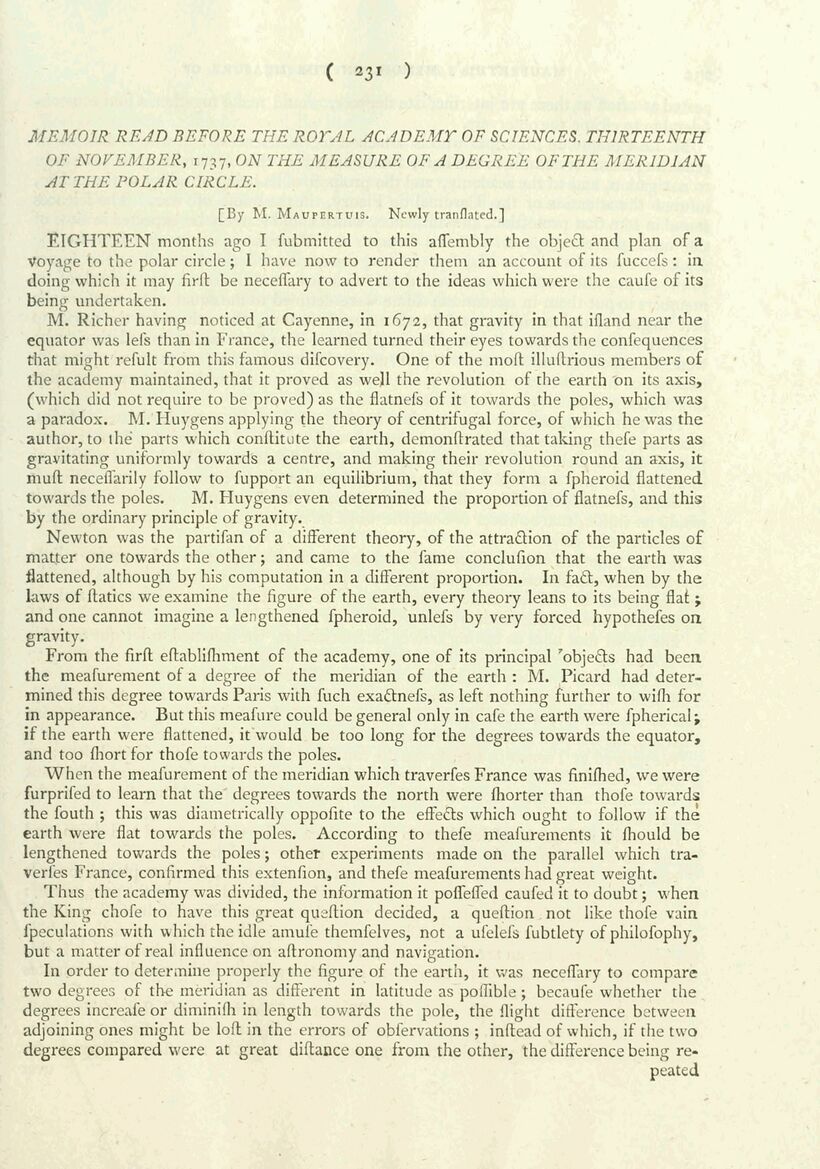
Full resolution (JPEG) - On this page / på denna sida - Pages ...

<< prev. page << föreg. sida << >> nästa sida >> next page >>
Below is the raw OCR text
from the above scanned image.
Do you see an error? Proofread the page now!
Här nedan syns maskintolkade texten från faksimilbilden ovan.
Ser du något fel? Korrekturläs sidan nu!
This page has never been proofread. / Denna sida har aldrig korrekturlästs.
("agme)
MEMOIR READ BEFORE THE ROYAL ACADEMY OF SCIENCES, THIRTEENTH
OF NOVEMBER, 1737,ON THE MEASURE OF A DEGREE OF THE MERIDIAN
AT THE POLAR CIRCLE.
[By M. Maurrrruis. Newly tranflated.]
EIGHTEEN months ago I fubmitted to this affembly the object and plan ofa
voyage to the polar circle; | have now to render them an account of its fuccefs: in
doing which it may firft be neceflary to advert to the ideas which were the caufe of its
being undertaken.
M. Richer having noticed at Cayenne, in 1672, that gravity in that ifland near the
equator was lefs than in France, the learned turned their eyes towards the confequences
that might refult from this famous difcovery. One of the moft illuftrious members of
the academy maintained, that it proved as well the revolution of the earth on its axis,
(which did not require to be proved) as the flatnefs of it towards the poles, which was
a paradox. M. Huygens applying the theory of centrifugal force, of which he was the
author, to the parts which conftitute the earth, demonftrated that taking thefe parts as
gravitating uniformly towards a centre, and making their revolution round an axis, it
mutt neceflarily follow to fupport an equilibrium, that they form a fpheroid flattened
towards the poles. M. Huygens even determined the proportion of flatnefs, and this
by the ordinary principle of gravity.
Newton was the partifan of a different theory, of the attraction of the particles of
matter one towards the other; and came to the fame conclufion that the earth was
flattened, although by his computation in a different proportion. In fact, when by the
laws of {tatics we examine the figure of the earth, every theory leans to its being flat ;
and one cannot imagine a lengthened {pheroid, unlefs by very forced hypothefes on
gravity.
From the firft eftablifhment of the academy, one of its principal “objects had been
the meafurement of a degree of the meridian of the earth: M. Picard had deter-
mined this degree towards Paris with fuch exa¢tnefs, as left nothing further to with for
in appearance. But this meafure could be general only in cafe the earth were fpherical;
if the earth were flattened, it would be too long for the degrees towards the equator,
and too fhort for thofe towards the poles.
When the meafurement of the meridian which traverfes France was finifhed, we were
furprifed to learn that the degrees towards the north were fhorter than thofe towards
the fouth ; this was diametrically oppofite to the effeéts which ought to follow if the
earth were flat towards the poles. According to thefe meafurements it fhould be
lengthened towards the poles; other experiments made on the parallel which tra-
verfes France, confirmed this extenfion, and thefe meafurements had great weight.
Thus the academy was divided, the information it pofleffed caufed it to doubt; when
the King chofe to have this great queftion decided, a queftion not like thofe vain
{peculations with which the idle amufe themfelves, not a ufelefs fubtlety of philofophy,
but a matter of real influence on aftronomy and navigation.
In order to determine properly the figure of the earth, it was neceflary to compare
two degrees of the meridian as different in latitude as poflible; becaufe whether the
degrees increafe or diminifh in length towards the pole, the flight difference between
adjoining ones might be loft in the errors of obfervations ; inftead of which, if the two
degrees compared were at great diftance one from the other, the difference being res
peated
<< prev. page << föreg. sida << >> nästa sida >> next page >>